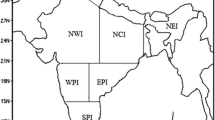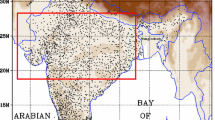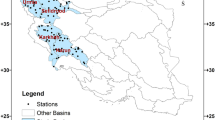Abstract
The operational medium range rainfall forecasts of the Met Office Unified Model (UM) are evaluated over India using the Contiguous Rainfall Area (CRA) verification technique. In the CRA method, forecast and observed weather systems (defined by a user-specified rain threshold) are objectively matched to estimate location, volume, and pattern errors. In this study, UM rainfall forecasts from nine (2007–2015) Indian monsoon seasons are evaluated against \(0.5^{\circ }\times 0.5^{\circ }\) IMD–NCMRWF gridded observed rainfall over India \((6.5^{\circ }{-}38.5^{\circ }\hbox {N}, 66.5^{\circ }{-}100.5^{\circ }\hbox {E})\). The model forecasts show a wet bias due to excessive number of rainy days particularly of low amounts \(({<}1\,\hbox {mm}\,\hbox {d}^{-1})\). Verification scores consistently suggest good skill the forecasts at threshold of \(10\,\hbox {mm}\,\hbox {d}^{-1}\), while moderate (poor) skill at thresholds of \({<}20\,\hbox {mm}\,\hbox {d}^{-1}\,({<}40\,\hbox {mm}\,\hbox {d}^{-1})\). Spatial verification of rainfall forecasts is carried out for 10, 20, 40 and \(80\,\hbox {mm}\,\hbox {d}^{-1}\) CRA thresholds for four sub-regions namely (i) northwest (NW), (ii) southwest (SW), (iii) eastern (E), and (iv) northeast (NE) sub-region. Over the SW sub-region, the forecasts tend to underestimate rain intensity. In the SW region, the forecast events tended to be displaced to the west and southwest of the observed position on an average by about \(1^{\circ }\) distance. Over eastern India (E) forecasts of light (heavy) rainfall events, like \(10\,\hbox {mm}\,\hbox {d}^{-1}\) (20 and \(40\,\hbox {mm}\,\hbox {d}^{-1}\)) tend to be displaced to the south on an average by about \(1^{\circ }\) (southeast by \(1{-}2^{\circ }\)). In all four regions, the relative contribution to total error due to displacement increases with increasing CRA threshold. These findings can be useful for forecasters and for model developers with regard to the model systematic errors associated with the monsoon rainfall over different parts of India.











Similar content being viewed by others
References
Ashrit R and Mohandas S 2010 Mesoscale model forecast verification during monsoon 2008; J. Earth Syst. Sci. 119(4) 417–446.
Ashrit R, Sharma K, Dube A, Iyengar G R, Mitra A K and Rajagopal E N 2015 Verification of short-range forecasts of extreme rainfall during monsoon; Mausam 66 375–386.
Bessafi M and Wheeler M C 2006 Modulation of south Indian Ocean tropical cyclones by the Madden-Julian oscillation and convectively-coupled equatorial waves; Mon. Weather Rev. 134 638–656.
Brown A R, Beare R J, Edwards J M, Lock A P, Keogh S J, Milton S F and Walters D N 2007 Upgrades to the boundary layer scheme in the Met Office NWP model; Bound.-Layer Meteorol. 118 117–132.
Brown A, Milton S, Cullen M, Golding B, Mitchell J and Shelly A 2012 Unified modeling and prediction of weather and climate: A 25-year journey; BAMS 1865–1878.
Chakraborty A 2010 The skill of ECMWF medium range forecasts during the year of tropical convection 2008; Mon. Weather Rev. 138 3787–3805.
Das S, Ashrit R, Iyengar G R, Mohandas S, Das Gupta M, George J P, Rajagopal E N and Dutta S K 2008 Skills of different mesoscale models over Indian region during monsoon season: Forecast errors; J. Earth Syst. Sci. 117(5) 603–620.
Davies T M, Cullen J P, Malcom A J, Mawson M H, Staniforth A, White A A and Wood N 2005 A new dynamical core for the Met Office’s global and regional modeling of the atmosphere; Quart. J. Roy. Meteorol. Soc. 131 1759–1782.
Dube A, Ashrit R, Ashish A, Sharma K, Iyengar G R, Rajagopal E N and Basu S 2014 Forecasting the heavy rainfall during Himalayan flooding – June 2013; Weather Clim. Extrem. 4 22–34.
Ebert E E 2008 Fuzzy verification of high-resolution gridded forecasts: A review of proposed framework; Meteorol. Appl. 15 51–64.
Ebert E E and McBride J L 2000 Verification of precipitation in weather systems: Determination of systematic errors; J. Hydrol. 239 179–202.
Ebert E E and Gallus Jr W A 2009 Towards better understanding of Contiguous Rain Areas (CRA) method of spatial verification; Wea. Forecasting 24 1401–1415.
Ebert E, Wilson L, Weigel A, Mittermaier M, Nurmi P, Gill P, Göber M, Joslyn S, Brown B, Fowler T and Watkins A 2013 Progress and challenges in forecast verification; Meteorol. Appl. 20 130–139.
Edwards J M and Slingo A 1996 Studies with a flexible new radiation code. I: Choosing a configuration for a large-scale model; Quart. J. Roy. Metorol. Soc. 122 689–719.
Gilleland E, Ahijevych D A, Brown B G and Ebert E E 2010 Verifying forecasts spatially; Bull. Am. Meteor. Soc. 1365–1373.
Goswami B N and Ajay Mohan R S 2001 Intra-seasonal oscillations and inter-annual variability of the Indian summer monsoon; J. Climate 14 1180–1198.
Goswami B N, Ajaya Mohan R S, Xavier P K and Sengupta D 2003 Clustering of low pressure systems during the Indian summer monsoon by intraseasonal oscillations; Geophys. Res. Lett. 30 1431, https://doi.org/10.1029/2002GL016734.
Grams J S, Gallus W A, Wharton L S, Koch S, Loughe A and Ebert E E 2006 The use of a modified Ebert-McBride technique to evaluate mesoscale model QPF as a function of convective system morphology during IHOP 2002; Wea. Forecasting 21 288–306.
Grant A L M 2001 Cloud base mass fluxes in the cumulus capped boundary layer; Quart. J. Roy. Meteor. Soc. 127 407–421.
Gregory D and Allen S 1991 The effect of convective scale downdraughts upon NWP and climate; Proceedings of 9 \({th}\) AMS conference on NWP, Denver, USA, pp. 122–123.
Gregory D and Rowntree P R 1990 A mass flux convection scheme with representation of cloud ensemble characteristics and stability-dependent closure; Mon. Weather Rev. 118 1483–1506.
Harper K, Uccellini L W, Kalnay E, Carey K and Morone L 2007 \(50{{\rm th}}\) anniversary of numerical weather prediction; Bull. Am. Meteor. Soc. 88 639–650.
Iyengar G, Ashrit R, Das Gupta M, Chourasia M, Sharma K D, Prasad V S, Rajagopal E N, Mitra A K, Mohandas S and Harenduprakash L 2011 NCMRWF & UKMO global model forecast verification: Monsoon 2010; Monsoon Report, NMRF/MR/02/2011.
Iyengar G R, Ashrit R, Sharma K and Rajagopal E N 2014 Monsoon 2013: Performance of NCMRWF global assimilation–forecast system; Monsoon Report, NMRF/MR/01/2014.
Jolliffe I T and Stephenson D B 2011 Introduction in forecast verification: A practitioner’s guide in atmospheric science; John Wiley and Sons Ltd., Chichester, UK, https://doi.org/10.1002/9781119960003.
Joseph S, Sahai A K, Sharmila S, Abhilash S, Borah N, Chattopadhyay R, Pillai P A, Rajeevan M and Kumar A 2014 North Indian heavy rainfall event during June 2013: Diagnostics and extended range prediction; Clim. Dyn. 44 2049–2065.
Kalnay E, Lord S J and McPherson R D 1998 Maturity of operational numerical weather prediction: Medium range; Bull. Am. Meteor. Soc. 79 2753–2769.
Maloney E D and Hartmann D L 2000 Modulation of eastern North Pacific hurricanes by the Madden-Julian oscillation; J. Climate 13 1451–1460.
Mandal V, De U K and Basu B K 2007 Precipitation forecast verification of Indian summer monsoon with inter-comparison of the three diverse regions; Wea. Forecasting 22 428–443.
Mitra A K, Bohra A K, Rajeevan M N and Krishnamurti T N 2009 Daily Indian precipitation analysis formed from a merge of rain gauge data with TRMM TMPA satellite-derived rainfall estimates; J. Meteor. Soc. Japan 87A 265–279.
Mitra A K, Momin I M, Rajagopal E N, Basu S, Rajeevan M N and Krishnamurti T N 2013 Gridded daily Indian monsoon rainfall for 14 seasons: Merged TRMM and IMD gauge analyzed values; J. Earth Syst. Sci. 122(5) 1173–1182.
Prakash S, Mitra A K, Momin I M, Rajagopal E N, Milton S F and Martin G M 2016 The skill of short- to medium-range monsoon rainfall forecasts from two global models over India for hydro-meteorological applications; Meteorol. Appl. 23 574–586.
Rajeevan M, Bhate J, Kale J D and Lal B 2006 High resolution daily gridded rainfall data for the Indian region: Analysis of break and active monsoon spells; Curr. Sci. 91(3) 296–306.
Rajesh P V, Pattnaik S, Rai D, Osuri K K, Mohanty U C and Tripathy S 2016 Role of land state in a high resolution mesoscale model for simulating the Uttarakhand heavy rainfall event over India; J. Earth Syst. Sci. 125(3) 475–498.
Rakhi R, Jayakumar A, Sreevathsa M N R and Rajagopal E N 2016 Implementation and upgradation of NCUM in Bhaskara HPC; Technical Report, NMRF/TR/03/2016, 22p.
Rawlins F, Ballard S P, Bovis K J, Clayton A M, Li D, Inverarity G W, Lorenc A C and Payne T J 2007 The Met Office global four-dimensional variation data assimilation scheme; Quart. J. Roy. Metorol. Soc. 133 347–362.
Roebber P J, Schultz D M , Colle B A and Stensrud D J 2004 Toward improved prediction: High-resolution and ensemble modeling systems in operations; Wea. Forecasting 19 936–947.
Rossa A, Nurmi P and Ebert E 2008 Overview of methods for the verification of quantitative precipitation forecasts; In: Precipitation: Advances in Measurement, Estimation and Prediction (ed.) Michaelides S, Berlin: Springer, pp. 419–452.
Sharma K, Ashrit R, Ebert E, Iyengar G and Mitra A K 2015 NGFS rainfall forecast verification over India using the Contiguous Rain Areas (CRA) method; Mausam 66 415–422.
Shepard D 1968 A two-dimensional interpolation function for irregularly spaced data; Proceedings of the 23 \({rd}\) ACM National Conference, New York, USA.
Simmons A J and Hollingsworth A 2002 Some aspects of the improvement in skill of numerical weather prediction; Quart. J. Roy. Meteorol. Soc. 128 647–677.
Walters D N, Best M J, Bushell A C, Copsey D, Edwards J M, Falloon P D, Harris C M, Lock A P, Manners J C, Morcrette C J, Roberts M J, Stratton R A, Webster S, Wilkinson J M, Willett M R, Boutle I A, Earnshaw P D, Hill P G, MacLachlan C, Martin G M, Moufouma-Okia W, Palmer M D, Petch J C, Rooney G G, Scaife A A and Williams K D 2011 The Met Office Unified Model Global Atmosphere 3.0/3.1 and JULES Global Land 3.0/3.1 configurations; Geosci. Model Dev. 4 919–941.
Webster S, Brown A R, Cameron D and Jones C P 2003 Improvements to the representation of orography in the Met Office Unified Model; Quart. J. Roy. Meteorol. Soc. 126 1989–2010.
Wilks D S 2011 Statistical methods in the atmospheric sciences; International Geophysical Series, Academic Press.
Acknowledgements
The authors are thankful to NCMRWF scientists for the valuable and fruitful suggestions in addition to comments/feedback that were useful in finalizing the manuscript. The model forecast data used in this study is obtained from the Met Office which is duly acknowledged.
Author information
Authors and Affiliations
Corresponding author
Additional information
Corresponding editor: A K Sahai
Rights and permissions
About this article
Cite this article
Sharma, K., Ashrit, R., Ebert, E. et al. Assessment of Met Office Unified Model (UM) quantitative precipitation forecasts during the Indian summer monsoon: Contiguous Rain Area (CRA) approach. J Earth Syst Sci 128, 4 (2019). https://doi.org/10.1007/s12040-018-1023-3
Received:
Revised:
Accepted:
Published:
DOI: https://doi.org/10.1007/s12040-018-1023-3




